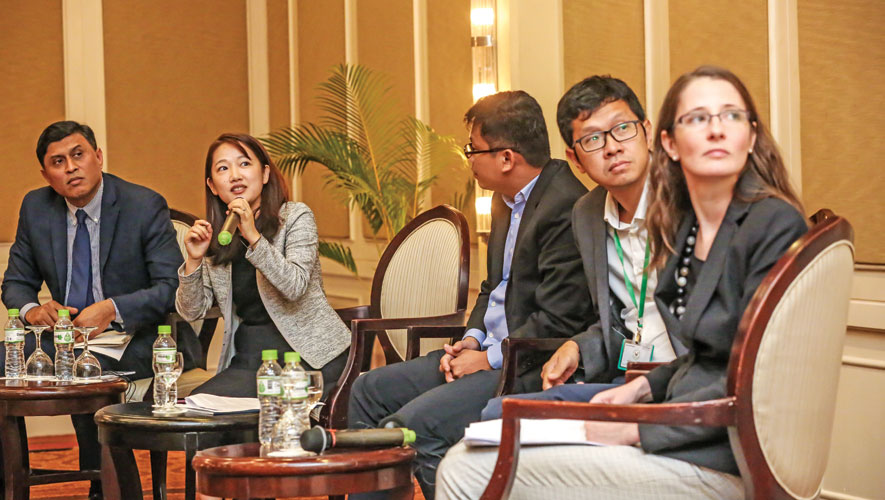Despite Cambodia’s remarkable participation in global value chains since the mid-1990s, the recent years have been marked by stagnation.
For the latest Cambodian Business news, visit Khmer Times Business
Unlike other countries in the region, Cambodia has not been able to diversify significantly beyond or upgrade garments and footwear, according to the World Bank.
A global value chain (GVC) refers to the series of stages required to produce goods or services that are sold to customers, with each stage adding value and with at least two stages conducted in different countries. GVCs account for around half of world trade today, the World Bank said.
Slowdown
It is integral to trade success so GVCs are critical to Cambodia for the creation of growth and jobs, said Deepak K. Mishra, practice manager of the World Bank Group.
“What we have seen is that global trade is going down and this actually happened way before the global crisis – and the slowdown started before the trade war between the US and China,” Mishra said.
He added the slowdown is happening in part because of technology reasons and also because of the rising trade tension between China and the US, so Cambodia will be affected in the future by the impact on imports and exports.
According to the World Bank, GVC participation is measured at the country or sectoral level. Backward participation is traditionally measured as the foreign value added embodied in a country’s or sectors gross exports.
Labour cost
Forward participation is traditionally measured as the domestic value added by a country or sector embodied in a third country’s exports. GVC participation is affected by both exports and imports.
To be successful in terms of participating in GVCs, the first factor is the labour cost, second is trade preferences and third is the business environment, says Chea Sopheak, deputy director of the macroeconomic and fiscal policy department of the Ministry of Economy and Finance.
Business environment
Chea says that when the labour cost is reasonable, more investors are interested in investing in the Kingdom. He adds that trade preferences are also important because they could be the incentive for attracting investors.
In addition to that, Chea says the business environment is crucial to boost Cambodia’s competitiveness. Therefore, the government has amended investment law and the law on special economic zones.
Low cost of labour
“Sooner or later, we will try to improve it, the way we practice, and please investors… so the business environment factor is also part of our attraction,” Chea adds.
Kim Veara, an economics lecturer, at the faculty of development studies at the Royal University of Phnom Penh, says that the success of Cambodia in the global value chain relies on the fact it is an Asean member state, so it can utilised as a potential for upgrading or joining the international market.
He adds one of the factors behind the success is that moving the value chain from garment to light manufacturing means Japanese companies have relocated some production to Cambodia to take advantage of the low cost of labour.
Weak links
However, it is a challenge for Cambodia to move into the global value chain because it has weak links between small and medium enterprises (SMEs) and foreign direct investment (FDI) SMEs.
“Local SMEs are very weak in terms of the capacity to supply the need of FDI firms and large firms, and currently SME products are low in quality. We can upgrade our SMEs to link to the larger firms, so the larger firm will help the SMEs by providing technology, technical knowledge and capital,” Kim adds.
In addition, the Kingdom has a shortage of skilled workers and a skill mismatch, he says.
Cambodia rapidly integrated into the global value chains much faster than other countries. GVC participation supported productivity improvements and employment growth among other aspects. All countries participate in GVCs, but not in the same way. Cambodia participates in limited manufacturing GVCs, says Claire Honore Hollweg, senior country economist of the World Bank Group.
Little diversification
“Cambodia’s participation has been concentrated in garments and there has been little diversification,” Hollweg says, adding the ability to move up to the next stage of participation requires a more sophisticated policy mixture.”
When everyone is talking about the global value chain, we are thinking of the Poipet SEZ (special economic zone), which is a very interesting place to study, says Michelle Zhao, general manager of Phnom Penh SEZ Plc.
Appeal to government
She says that Poipet SEZ’s tenants are the manufacturers of electronic parts and automobile parts, which are high added-value products. The tenants move some processing from other countries to Poipet and then they can support their mother factory in neighbouring Thailand, for example.
“Right now, our Poipet SEZ has one factory – Sumitronic from Japan. It produces electronic components.
“It imported raw materials from Thailand and then it transferred its work to another manufacturing area. While it operates this business model, it faces two issues. First, it has to pay 10 percent VAT (value-added tax) and second, there are no rules or regulations for CMT – cut, make and trim. We refer to the processing aspects. They cannot do this in Cambodia except in garment factories,” Zhao adds.
Focus on private sector
Zhao is appealing to the government to consider a more sophisticated policy to non-garment manufacturers in Cambodia when there is a talk about upgrading the global value chain in Cambodia.
Chea, however, added the government is thinking about more measures to address the issue as soon as possible based on the medium and long term. He says the government is now under the amendment investment law and the SEZ law.
“We are now prioritising by focusing on the private sector, so I believe it is not only the garment sector which receives special treatment. Of course, the other sectors – spare parts – those are the ones that are being put under investment law,” Chea adds.
He says that the law now is more targeted than the previous one, which was more generic. However, at present the competition is harsh so the government is trying to focus the sector more specifically.
“We need to be more focused, thinking more strategically and practically,” Chea adds.
Step by step
“It does not mean we have to address all the issues brought by the private sector. We have to go step by step. We have to keep thinking, learning and hearing about what the private sectors concern’s are, either new or old, so we can find measures to address them,” Chea points out.
“I cannot promise to solve everything, but next year, you will see the second wave of reform measures by the government as we did in March 2019 – but I do not know which month. We keep trying to monitor to see what works and what does not work,” Chea adds.
The World Bank said that in order for Cambodia to move to the next stage of participation, a much more sophisticated policy mixture is needed, which should include the following.
First, the expansion and deepening of trade agreements to go beyond the issues of market access and national treatment.
Lower trade barriers
Attention should also be paid to contract enforcement, protecting intellectual property rights and strengthening national certification and testing capacity to ensure compliance with international standards to facilitate greater GVC participation.
Second, there should be lower barriers to trade and connection to markets to expand Cambodia’s small domestic market size and improve access to the input needed for production.
Reducing tariffs, improving customs and border procedures, promoting competition in transport and logistics services, improving the business environment and enhancing port structure and governance can reduce trade costs related to time and the uncertainty of trading.
Strengthen capacity
Third, there should be continued improvement in the education and skills of Cambodia’s labour force.
To strengthen domestic capacity and support upgrading in value chains, Cambodia should invest in human capital, it is argued.
In 2013, the UN Conference on Trade and Development concluded GVCs make a significant contribution to international development.
Value-added trade contributes about 30 percent of GDP of developing countries, significantly more than it does in developed countries (18 percent).
GVCs have a direct impact on the economy, employment and income and create opportunities for development.
They can also be an important mechanism for developing countries to enhance productive capacity by increasing the rate of adoption of technology and through workforce skill development, thus building the foundations for long-term industrial upgrading.
Value-added activities
However, developing countries face the risk of operating in permanently low-level value-added activities with potential negative effects on the environment and social conditions, including poor workplace conditions, occupational safety and health and job security.
The relative ease with which the value chain governors can relocate their production, often to lower-cost countries, also creates additional risks.
Global supply chain management is facing the increasing difficulty in predicting demand variability in different areas.
In addition, managing the production and transportation of goods over large distances to meet the peak demand represents another challenge.
Integrating global value chains requires all actors to adapt to technological changes, which is capital-intensive.
Therefore, it is safe to say that this trend significantly benefits developed countries rather than developing countries.




